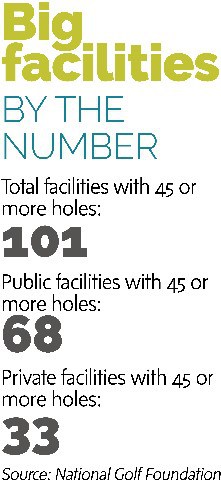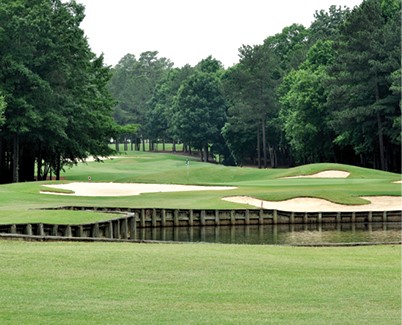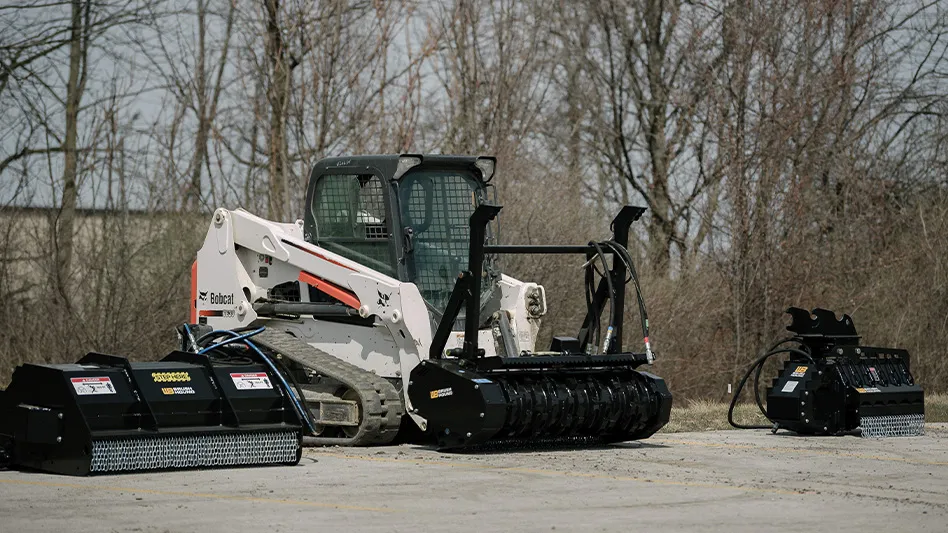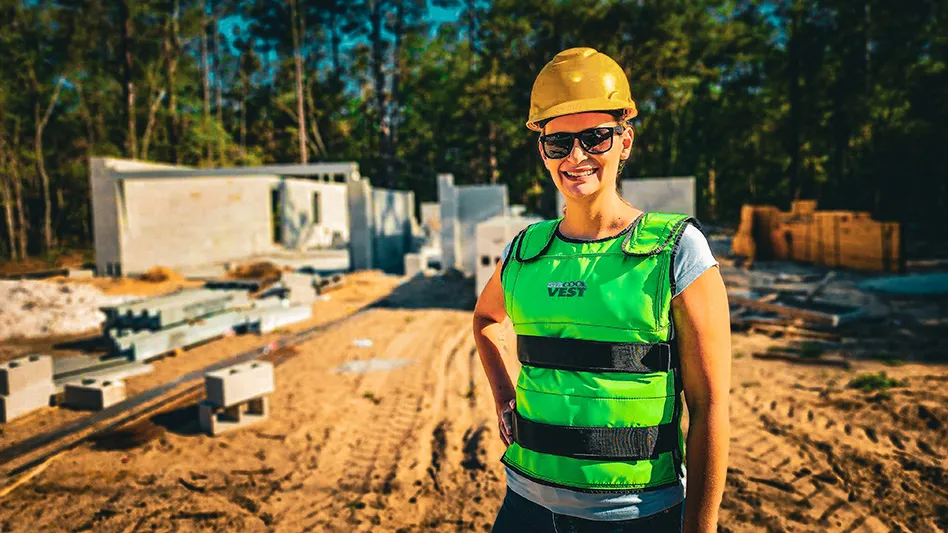
Any successful golf course superintendent appreciates the joys and challenges that come with the job. But the task of overseeing a facility with more than one golf course brings additional issues.
Those issues go beyond maintaining a more sizable amount of land with multiple varieties of turf. They include scheduling and logistics, budgeting and, most important, staffing — having the right people in the right places, seeing to it that they are trained properly and then giving them enough latitude to carry out their responsibilities.
Jim Roney is the director of golf courses and grounds at Saucon Valley Country Club in Bethlehem, Pennsylvania. The 850-acre site features three 18-hole championship courses — the Old, the Grace and the Weyhill, plus a six-hole short course.
In his almost 17 years at Saucon Valley, Roney has hosted two USGA championships, the 2009 U.S. Women’s Open on the Old Course and the 2014 U.S. Mid-Amateur on the Old and the Weyhill. During the season, Roney utilizes a full-time staff of 70 plus 30 to 40 part-timers. The year-round staff numbers 45.
The three courses are similar agronomically in some ways, different in others. The Old Course, which was completed in 1921, has pushup greens that were regrassed with A1-A4 bentgrass in 2006.
The Grace Course, which welcomed nine holes in 1953 and nine more in 1958, features Poa greens, while Weyhill, completed in 1968, has had USGA bentgrass greens since 2010.
What’s important to Roney is taking the same approach to managing all three. “They’re all managed at a championship condition on a daily basis,” he says. “At Saucon, you’re going to get the same experience from a quality perspective on all three of the golf courses.”
A superintendent is in charge of each course. They are regarded as superintendents, not as assistants. “These superintendents do way more than an assistant superintendent would do,” Roney says.
Each superintendent has a team under him. That team stays intact save for special circumstances, such as an aerification or a chemical application, when assistants assigned to all three courses will team up.
Roney gives his course superintendents considerable autonomy. “When it comes to writing the fertility schedule on the calendar for any agronomic or cultural practices, I’m writing all that stuff,” he says. “All the spray applications, all the fertility, all those specific things I do, but then I’ll pull in the superintendents and kind of review the calendar on where we’re able to make those applications and give a window and then I let them kind of run with it.
“When it comes to preparing the golf course each day, I have parameters that I set out but let (the superintendents) schedule that stuff. Things like green speeds or firmness, moisture levels in the greens or in the fairways, water cycles, things like that, those are all parameters that I set out, or I establish, but then there is some flexibility with each of those superintendents to make some adjustments. And that’s important, because I have two shops and I’m only one person, so I can’t really do all the morning meetings. So, I try to bounce around as much as I can.”
Roney stresses that effective communication is essential to the success of his operation.

“We do a lot of communicating with radios and text messages, cell phones, e-mails,” he says. “I’ll make notes throughout the day and then I’ll share those notes with the superintendent and the assistants and then mandate, quite honestly, that they are communicating amongst themselves.”
From his notes and observations, Roney will make decisions about where to focus his attention and where and how to coach his assistants.
“It’s important for my notes to get disseminated properly,” he says, “so if I see one of the assistants I’m going to say ‘OK, this is your time to shine. These are the four things I want you guys to work into the schedule for tomorrow. Make sure you speak to Gavin or Frank or Kevin or Doug.’
“And that meeting will occur prior to the end of the day where a schedule will be put together and then that schedule will be e-mailed to me. I’ll review that schedule and then if there are some tweaks that need to be done to that then we’ll make those tweaks at that point.
“And then in the morning I know exactly where I need to go and which golf course I need to go to. There’s just too much work for one person so I have to manage the superintendents and assistant superintendents and kind of coach them to make the right decisions.”
Roney is in the midst of preparations for the 2022 U.S. Senior Open, which will be played over the Old Course next June.
“I want to make sure my whole team is able to experience that,” he says. “So everybody is going to have a responsibility with regard to the Senior Open. Certainly, the team that is on the Old Course right now, they’re going to have a significant impact on the success of that championship, but everybody is going to be exposed to some aspect of it.”
Putting it all together in the Pacific Northwest
Ryan Semritc is the superintendent at the Willows Run Golf Complex, a public facility in Redmond, Washington, that features two 18-hole layouts plus a nine-hole course. He tends to 49 greens in all.
Semritc, who arrived at Willows Run five years ago, oversees a year-round staff of 12 that swells to 30 to 35 during the peak golf season, May 1 to Oct. 1. During that time, the tee sheet is full: the club hosts approximately 100,000 rounds each year.
To make it all work, Semritc manages and maintains the three courses as if they were one. “In my mind we’re all working together,” he says. “I just treat it as one golf course instead of three golf courses. Instead of sending one triplex out to mow greens, we just send three triplexes out to mow greens.”
Semritc has three assistant superintendents working under him. The assistants could find themselves spending their workday anywhere on the complex.
“We don’t have one designated for each course,” Semritc says. “We just designate each day, one assistant has to check that course out; one of the assistants every day sees each golf course. Every day, an assistant is in charge of seeing every single hole on a certain golf course, basically as cover when I don’t.”
Semritc believes the one-course approach helps his team do their jobs more efficiently.

“We have one maintenance shop and the golf courses are all together,” he says. “You could see across one course’s holes and one hole is next to a hole on a different golf course. It’s all really close. Separating it isn’t as efficient as treating it like one big 54-hole golf course.”
To supplement his full-time/in-season work force, Semritc utilizes a corps of retirees and semi-retirees who were largely recruited via notices in the locker room.
“Over the last five years we’ve built a stable of about 16 semi-retired employees who have come back every year,” Semritc says. “They work through the season. Some of them are either semi-retired or just retired. They work two to four days a week.”
Semritc says his part-timers bring with them a strong work ethic and a professional mindset.
“Usually they’re guys who were pretty accomplished in other professional fields,” he says. “There’s no doubt that they’re here on time. They’re not running late, they don’t have an excuse for this, an excuse for that.
“I did the high school and college kid thing for a long time. The biggest problem with the college kids and the high school kinds is they don’t get out of school until June and then they’ve got to go back September 1st. That misses a big window of our season. So finding the retired guys was huge. It allowed us to go from having 20 full-time employees in the summer to having 35 people here in the morning, but 16 or more of them leave at 11 o’clock.”
Semritic says there are often occasions when he relies on his part-timers for their professional expertise in other fields.
“One of them was the safety manager for a national construction company,” he recalls.” So when we have (an OSHA inspection) coming and I have to prepare for an OSHA thing, I have the guy who can say, ‘Let’s sit down and take care of that,’ or he brings up, ‘Hey, you really need to change this,’ or ‘You need to do this differently.’ Because he’s an expert in that.
“These guys have a wealth of knowledge that may be from a different field, but on a weekly basis we end up applying it.”
Carolinas coordination
Lee Hancock is the director of golf course maintenance at Prestonwood Country Club in Cary, North Carolina, where he’s spent the last six years. The 500-acre site includes three golf courses.The Meadows Course, which opened in August 1988, and the Highlands Course, January 1993, feature Bermudagrass greens. Nine holes from each course are utilized every fall for the SAS Championship, a PGA Tour Champions event.
The Fairways Course, which opened in January 1995, features bentgrass greens. In a normal year, the club will host approximately 85,000 rounds but that total exceeded 110,000 last year, a club record.
Hancock’s staff includes three superintendents and six assistants, as well as a landscape manager, an equipment superintendent and an irrigation superintendent. During the growing season, the staff numbers more than 70. That number drops to 40 to 45 in the offseason.

Hancock strives for consistency in his maintenance practices. “The Meadows and Highlands programs are identical,” he says. “The date of applications may vary a day or two (but) cultural practices are performed as simultaneously as possible. During the summer, I aerify the Fairways Course in early June, wait three weeks to aerify the Meadows Course in late June, then we wait three weeks for it to heal and then we do Highlands Course. This ensures a great playing surface for the membership year-round.”
When it comes to allocating labor resources, Hancock seeks to strike a balance. “We all work out of one facility,” he says. “The teams predominantly manage their own respective areas but during special events, tournaments and aerification weeks, we always help one another out. We all chip in to help pull greens covers on the two Bermudagrass courses.
“The equipment is shared at times, but we have a large enough fleet to mow out all 54 holes. Sometimes the guys on one course might finish mowing their course and jump over to help another course finish out so everyone can be in for lunch on time. We try to manage as a team and be unified, but obviously the competitive spirit comes out in everyone and the guys want to be the best course on property.”
Hancock spends much of his workdays interacting with his superintendents, his general manager, the golf staff and the club’s administrative staff. He stresses the importance of thinking ahead.
“Trying to circulate 500 acres is a tall task,” he says. “I am usually thinking about the next day or week — whatever is happening today was already thought about yesterday or last week or even last year in some cases. When things are going right, I try to stay out of their way so the ‘machine’ can keep on rolling.”
Hancock believes that hiring the right people and training them properly is essential to a successful operation.
“Like any business, having the right people on board is imperative,” he says. “We need people who want to succeed and are willing to go the extra mile at times to ensure success. I am big on accountability. I hope to give the guys the information they need to do their job, give them the tools to be successful, give them the opportunity to succeed with a good agronomic schedule, help manage and watch weather patterns and give insight on long-range planning and projects. I expect the superintendents to be able to manage the day-to-day operations on their own.
“My superintendents are smart guys and I always want them to be able to be the best version of themselves at work. I am a huge believer in ‘individuality’ and want the staff to feel empowered to make decisions and be creative in their work. I often say that it is up to us to make this a good place to work, for ourselves and our team members. I trust my guys. We communicate all the time and we have fun at this job when we can.”
Roney, Semritc and Hancock all face challenges unique to their individual facilities, as does any other turf manager. But they all embrace the concept of teamwork and the importance of empowering their team.
That’s a model for anyone managing a business, but one that is especially applicable in the turf industry.
Semritc, who was the superintendent at two other facilities before arriving at Willows Run, learned quickly about the importance of delegating.
“At an 18-hole golf course, especially one with a smaller budget, you end up doing a lot by yourself for good and for worse,” he says. “That gets built into you. The downside is you start to think, ‘I can do a lot of this by myself.’
“Well, when you come to 54 holes, you learn really fast you can’t do it all by yourself.”

Explore the February 2021 Issue
Check out more from this issue and find you next story to read.
Latest from Golf Course Industry
- Devising safer landings
- SiteOne adds Durentis to product offerings
- Resilia available for purchase in Hawaii
- What can $1 million do for expanding the industry workforce?
- Captivating short course debuts on Captiva Island
- Wonderful Women of Golf 35: Carol Turner
- The Andersons acquires Reed & Perrine Sales
- Excel Leadership Program awards six new graduates





